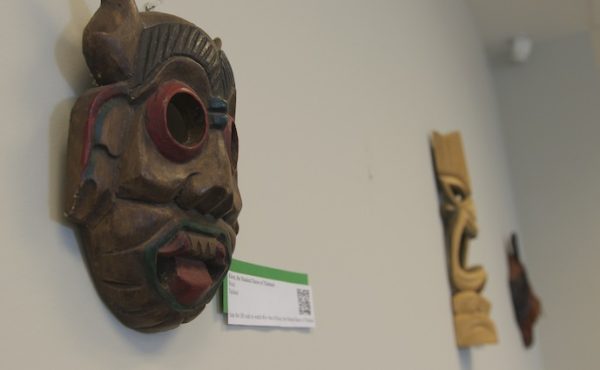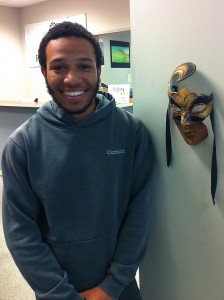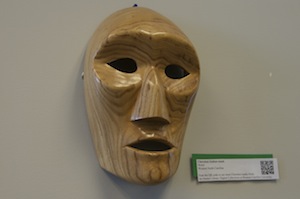Student-Curated Mask Exhibit Offers Glimpse of Unique Cultures

Masks have served as a symbol of cultures around the world for centuries. They are made of different materials; some are wood, while others are metal. They feature different colors and shapes; some are round while others are elongated. Masks are unique and through their appearance, they can communicate about the unique people and cultures they represent.
For UNC Charlotte English major Jarred Hamilton, creating an exhibit of masks in UNC Charlotte’s Language Resource Center presented an opportunity to communicate about cultures while using visual and digital features. As visitors view each piece in the mask collection, they will see a description of the piece and a QR code. The QR code gives more insight into the piece.
“We live in a digital age,” Hamilton said. “It’s a way for students to say: “Oh wow, this mask is from Indonesia and it’s mahogany wood.” They can scan the QR code and find out more information about it at the touch of a button.”
 For the Language Resource Center, the masks offer a strong example of how people communicate – beyond just written words on paper. The Language Resource Center is a technology-enhanced facility that supports foreign language and ESL learning and teaching. It specifically supports the students and faculty in the Department of Languages and Culture Studies and the English Language Training Institute and is located on the fourth floor of the College of Education, Room 434.
For the Language Resource Center, the masks offer a strong example of how people communicate – beyond just written words on paper. The Language Resource Center is a technology-enhanced facility that supports foreign language and ESL learning and teaching. It specifically supports the students and faculty in the Department of Languages and Culture Studies and the English Language Training Institute and is located on the fourth floor of the College of Education, Room 434.
“The Language Resource Center involves instructional technology and supporting the study of languages and cultures,” said Bobby Hobgood, center director. “We thought this was a great way to bring in the technology and at the same time reinforce the art.”
Hobgood proposed the idea to Hamilton, a student employee, after realizing that the existing art in the Language Resource Center needed an upgrade.
“The collection is actually my personal collection,” Hobgood said. “When I arrived here on September 2, there were some existing photos on the walls, but they were old and faded. I spoke with the students on what we could do to bring a little more interest into the space.”
The exhibit is called “Mask,” and showcases eight masks from eight different cultures around the world. Included with the exhibit is an overview that states the importance of masks in cultures around the world.
“Hobgood has 20-plus masks and I wanted to feature masks from everywhere,” Hamilton said. “He told me to choose the masks along with the information and run with it. He had three masks from Haiti, and I knew I didn’t want to put three masks from the same country in an exhibit with eight masks.”
After Hamilton chose the final masks to include in the exhibit, he decided how he was going to arrange the masks and conducted research. He found the name of each mask and its culture while also researching masks in general and how they fit into a culture for the overview.
“Some of the masks say where they are made, so that’s a given,” Hamilton said. “Others I had to find the exact mask. I had to look up tons of masks sites and see if I could find a similar one or that exact one. In searching for them, I looked for characteristics that were similar.”
Hamilton and Hobgood encourage the UNC Charlotte community and the broader community to stop by the Language Resource Center to gain a personal insight on the exhibit. They said they hope visitors will learn that while cultures are very different, creating masks to reflect a culture is an example of how different cultures can be similar.
“The exhibit is a way for students to get a little bit of the world in a smaller space,” Hamilton said. “Students will learn something new and learning about new cultures and people is important.”
Words: Brittany Algiere, Student Communications Assistant
Image of Hamilton courtesy of Hobgood